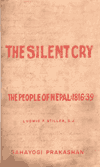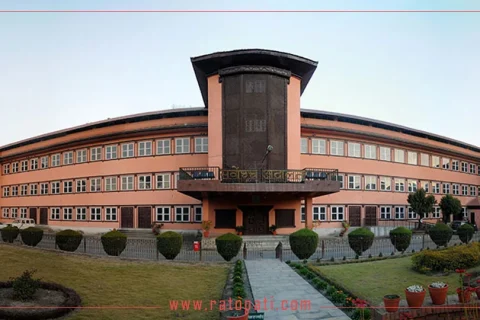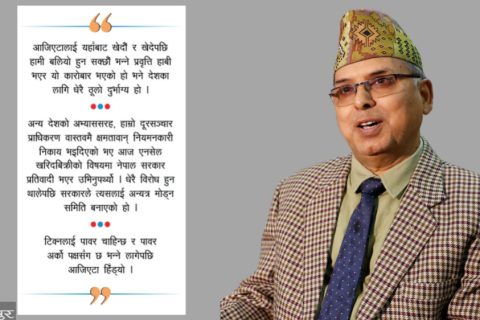
Ludwig F. stiller, S.J., The Silent Cry: The People of Nepal: 1816 -1839 (Kathmandu: Sahayogi Prakashan, 1976)
The Silent Cry is the story of the People of unified Nepal during a trying period of adjustment and searching of goals. This story begins with the Treaty of Sugauli signed in 1816 and continues through to the death of Prime Minister Bhim Sen Thapa in 1839.
In this book, Ludwig F. Stiller, a leading Nepalese historian, has described the Treaty of Sugauli as “a beginning rather than an end to Nepal’s time of troubles.” The Treaty was signed on December 2, 1815 and ratified by March 4, 1816, between the British East India Company and Nepal ending the Anglo-Nepalese War (1814–1816).
The Treaty of Sugauli called for – territorial concessions in which parts of the unified Nepal were given to British India, the establishment of a British representative in Kathmandu, and allowing Britain to recruit Gurkhas from Nepal for their military service. By virtue of this Treaty, Nepal also lost the right to deploy any British, American or European employee in its service without British approval. Earlier several French commanders had been deployed in Nepal to train the Nepali army.
Under the Treaty, about one-third of Nepalese territory was lost, including Sikkim (whose Chogyals supported Britain in the War); territory to the west of the Mahakali River like Kumaon and Garhawal (present Indian state of Uttarakhand); some territories to the west of the Sutlej River like Kangra (present day Himanchal Pradesh); and much of the Tarai region. A part of the Tarai Region was restored to Nepal under a revision of the treaty and more territory was returned in 1865 to thank Nepal for helping the British to suppress the Indian rebellion of 1857.
The Silent Cry is a book that describes Nepal’s people and their polity in the next twenty-three years after the ratification of the Treaty of Sugauli. It is the period that has been largely ignored in the modern history of Nepal.
The book is divided into four parts. The first three chapters provide an analysis of the situation prevailing in Nepal at the time. This analysis covers the seeds of conflict with the British India, the trauma of defeat of the war, the details of village Nepal at that time and government constraints in the post-war perspective.
In the fourth, fifth and sixth chapters, the author covers the movements of Nepal towards greater internal unity at the regional and village level as well as the obstacles that hindered that growth. Here the author deals with Bhim Sen Thapa’s authority, the Nepal China affair, the restoration of Tarai, the intrigue in Kathmandu, army discontent, and Nepal’s involvement with Sindhia. His analysis of the growth of unity and revenue collection policies in the post-war perspective comes next. After this, the author talks about the ‘Sanskritization’ process as well.
Chapters seven, eight and nine explore the dialogue that took place between the central administration of the unified Nepal in Kathmandu and its villages and explain the administration’s failure to respond to the needs of the peasantry. Here the author discusses insecurity and unrest that emerged in the context of the ceiling on Jagirs, the struggle for security, the emergence of a pressure group, the restless army, the conflict between Bhim Sen Thapa and the Residency, and the events leading to his downfall.
In the last chapter, the author has restated the major themes of The Silent Cry and tried to explain the nuances of this title.
According to Stiller, the silent years – ‘the years of unheard cry’ were the cry of the common Nepalis in the postwar perspective. The cry went up from rural Nepal. It was a cry of pain and a cry of protest against official indifference to their plight. It was the cry of the system calling for change. At the root of the problem was the newly set up administration, the tax and revenue system, justice process, and lack of protection to the common people. The cry went unheard. Although he achieved a great deal for Nepal when he succeeded in gaining a restoration of more of the Tarai land than the British governor general had first envisioned when he made his proposal in 1816. But people wanted more efficient administration, some regular and accepted channels of communications, relief from the burden of taxes, and so on. It appeared in the silent years that Thapa was concerned primarily about his own position in society. He remained a strong promoter of his family interests. The essential failure of the Bhim Sen Thapa’s administration was simply a lack of vision as to how to run the newly unified country. Stiller points out:
Bhim Sen Thapa lost touch with the people of Nepal because he lacked vision; and the people of Nepal failed to move towards a greater unity and a true sense of Nepali nationhood because he lacked vision. He saw no greater goals to strive for. His administration and his own actions were all bound up in maintaining the status quo. He was satisfied with what the state had and with what he had, an attitude no serious politician can afford or accept.
The unified Nepal, according to Stiller, was not able to keep up with three basic ideas that King Prithvi Narayan Shah had bequeathed to the nation. He links this conclusion with Prithvi Narayan Shah’s belief that the nation walked on two legs, the farmers of ‘village Nepal’ as well as the military rank and file; that a rich peasantry made a rich country; and that good government depended on nobility of service. Stiller points out: “somewhere on the road to conquest, amid the crash of guns and the sweat of battle, these ideals were lost.”
The Silent Cry that Nepal was living with was not without result. “From 1839 until 1846 Kathmandu would know nothing but alarms, changes in ministries, increasing tension, and finally the explosive night of the Kot Massacre, the fourteenth of September 1846.” The author reminds of the close connection between the events and policies of the silent years and the emergence of Jung Bahadur. The silent years ended with such violence largely because the cry of rural Nepal and the Nepali nation had gone unheeded. The author, who released the book in 1976, remarks that the modalities of the cry have changed now and there is change in the content as well. But he argues “the cry is still there.” The question is “will it be heard any more closely than it was during the silent years?.”
For a student of law, Stiller’s analysis of the problem of ‘Sanskritization’ and its results is interesting. He has tried to explain ethnic diversity and customary law in the newly unified state, the ideal of Hindu law and unity, and the beginning of the process of ‘Sanskritization.’ Here, the author banks much on references on Hindu law, as practiced elsewhere, rather than legal rules produced in the new state. His use of the term ‘Sanskritization’ in the contents that he has been reflecting on seems over generalized, or a little too much. One must however agree with his finding that “not only was the legal dialogue of the silent years building up a record of legally sanctioned differences in custom and practice, it was also building up a record of differences in treatment meted out to citizens of different ethnic and caste backgrounds.”
Finally, it must be pointed out that in his preface, the author gives an important note of caution: “The reader will be well aware that my conclusions are far from a final statement of the events of the ‘silent years’. I hope he will be equally aware that ‘the silent cry’ chronicled in these pages is not the dying echo of the distant past but a challenge to all of us today to realize that we are in truth our brother’s and sister’s keeper.” This is an impressive book which must be read by anybody who wants to link up contemporary Nepal to its history.









